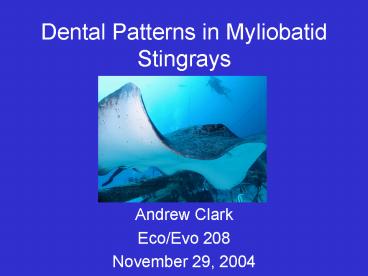Dental Patterns in Myliobatid Stingrays - PowerPoint PPT Presentation
1 / 16
Title:
Dental Patterns in Myliobatid Stingrays
Description:
Manta (Manta rays) Gonzalez-Isais & Dominguez, 2004. Introduction. Myliobatidae: Myliobatoids ... Or a different means of tooth replacement? ... – PowerPoint PPT presentation
Number of Views:98
Avg rating:3.0/5.0
Title: Dental Patterns in Myliobatid Stingrays
1
Dental Patterns in Myliobatid Stingrays
- Andrew Clark
- Eco/Evo 208
- November 29, 2004
2
Introduction
- Family Myliobatidae
- highly specialized group of batoids
- morphology and diet
- at least 6 genera
- 4 durophagous genera
- 2 planktivorous genera
Gonzalez-Isais Dominguez, 2004
3
Introduction
- Family Myliobatidae
- Genera
- Myliobatis (Eagle rays)
- Aetomylaeus (Smooth-tail eagle rays)
- Aetobatus (Bonnet rays)
- Rhinoptera (Cow-nose rays)
- Mobula (Devil rays)
- Manta (Manta rays)
Gonzalez-Isais Dominguez, 2004
4
Introduction
- Myliobatidae
Myliobatoids
Rhinopterids
Mobulids
Durophagy
Planktivory
5
Durophagy
- Benefits
- lower competition for resources
- lower demand for high-speed pursuit
- Constraints
- need to produce high compressive loads
- risk to injury
- prey handling times are increased
6
Introduction
- Durophagous Myliobatids
- flattened tooth-plates
- fused mandibular symphyses
- trabecular cartilage in jaws
Rhinoptera
Dasyatis sabina
Rhinoptera
Rhinoptera
Summers, 2000
7
Introduction
- Tooth-plates vary among genera
Aetobatus
Aetomylaeus
Myliobatis
Rhinoptera
Rhinoptera
8
Introduction
- Durophagous Myliobatids
Rhinoptera
Aetomylaeus
Aetobatus
Myliobatis
Loss of hexagonal dentition
Hexagonal dentition
Durophagy
9
Questions
- Why does Aetobatus dental pattern differ from
other genera of Myliobatids? - A more diverse diet?
- Or a different means of tooth replacement?
- What is the significance of hexagonal dental
patterns? - Crushing performance?
- Tooth replacement?
10
Hypotheses
- Dental pattern anomaly of Aetobatus corresponds
to a more diverse diet and is less resistant to
compressive loads - Hexagonal patterns in Myliobatid dentition is the
optimal design for a hard prey diet
11
Experimental Design Aetobatus dentition
- Create models of tooth-plates that correspond to
each genus - equally sized models of the same material
- Apply compressive loads to models
- Record magnitude of force required to induce
tooth breakage
12
Experimental Design hexagonal patterns
- Create models of different dental patterns
- equally-sized models of the same material
- hexagonal patterns will be compared with
tetragonal and octagonal patterns - Apply compressive loads to models
- Record magnitude of force required to induce
tooth breakage
13
Possible Results
- Aetobatus experiments
- If Aetobatus model equally resistant to
compression - Differences due to tooth replacement
- If Aetobatus model less resistant to compression
- Dental pattern corresponds to a more diverse diet
- If Aetobatus model more resistant to compression
- Aetobatus evolved an improved dental pattern for
crushing hard prey
14
Possible Results
- Experiments on hexagonal patterns
- If all models show equal response to compressive
loads - Dental pattern is not associated with durophagy
- Different means of tooth replacement?
- If hexagonal models more resistant to compression
- Hexagonal dental patterns are the optimal design
for durophagy - If hexagonal models less resistant to compression
- Dental pattern is not associated with durophagy
- Different means of tooth replacement?
15
Additional Studies
- Determine the significance of different row
numbers and row lengths - Do different row numbers and row lengths relate
to crushing performance? - Measure bite force between genera and species of
Myliobatids - Is there a relationship between bite force and
dental patterns?
16
References
- Gonzalez-Isais, M. H. Dominguez. 2004.
Comparative anatomy of the superfamily
Myliobatoidea (Chondrichthyes) with some comments
on phylogeny. Journal of Morphology. 262
517-535. - Summers, A. 2000. Stiffening the stingray
skeleton - an investigation of durophagy in
Myliobatid stingrays (Chondrichthyes, Batoidea,
Myliobatidae). Journal of Morphology. 243
113-126.































